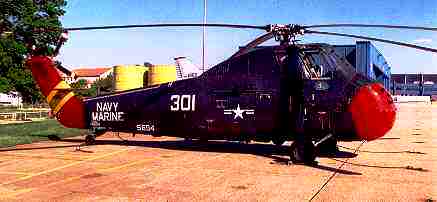

|
|
 |
 |
This picture was taken and furnished by John Benton. This is #145694 restored and on display at NAS Willow Grove, PA. |
| Engine | Wright R-1820-84 |
| Horse Power | 1525 |
| Crew | 2 |
| Max speed | 123 mph |
| Range | 384 miles |
| Ceiling | 4000 ft |
| Length | 47 ft 2 in |
| Rotor diameter | 56 ft |
| Height | 15 ft 10 in |
| ALSO KNOW AS | S-58, HSS Navy, H34 Army, SH34J, HUS SEAHORSE Marine |
1952 the Navy ordered a new ASW helicopter from Sikorsky. It was given the designation S-58 by Sikorsky and HSS Seabat by the Navy. The Marines knew it as the HUS Seahorse and the Army call it the H-34 Choctaw. After all this confusion it was settled, the civilian version would be S-58 and military would be the H-34 and SH-34. There were over 2,250 produced in various models.
The crew of two, pilot and the co-pilot on top and slightly behind a 1,525 hp Wright 84 piston engine. The Seabat had a top speed of 123 mph and a range of 384 miles..
The Sikorsky S-58 was a very successful general-duty helicopter. The radial engine was fitted in the nose as in the H-19, but the fuselage was more streamlined: the box-and-boom design of the H-19 was replaced by a simply tapering structure, the aft end of which could be folded. The type was known as HSS or HUS in USN and USMC service, and was license-built by Westland as the Wessex (with a turbine engine). The S-58 also pioneered airline helicopter operations. Some are still flying, often converted with turbine engines. 2261 were built.
Time Line
1956 First helicopter approved by the Navy for instrument flight rating.
1956 First helicopter to use automatic flight control system.
1956 First helicopter with automatic hover positioning system.
1957 Was used by President Eisehower to become the first American President to use a helicopter built specifically for his needs.
1959 The first helicopter to be used for power line construction.
1960 Was the first helicopter to fire radio controled missiles.
1960 Was the first helicopter
to retrieve an U.S. astronaut, Commander Alan Shephard, America's first
man in space.
Copyright © 2000NASGIVM All rights reserved.
Revised: June 30, 2010